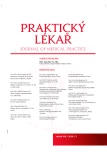Diagnosis and treatment of Latent Autoimmune Diabetes in Adults in everyday clinical practice
Authors:
J. Brož 1; K. Melicharová 1; L. Koberová 1; L. Brunerová 2; J. Urbanová 2
Authors‘ workplace:
Interní klinika 2. LF UK a FN Motol, Praha, Přednosta: prof. MUDr. Milan Kvapil, CSc., MBA
1; Centrum pro výzkum diabetu, metabolismu a výživy, II. interní klinika 3. LF UK a FNKV, Praha, Přednosta: prof. MUDr. Ivan Rychlík, CSc., FASN, FERA
2
Published in:
Prakt. Lék. 2020; 100(3): 140-142
Category:
Of different specialties
Overview
Latent Autoimmune Diabetes in Adults is a heterogeneous disease that is characterized by a less intensive autoimmune process and a mild metabolic decompensation at onset compared with young-onset type 1 diabetes mellitus (T1DM). The majority of patients with adult-onset autoimmune diabetes usually do not require insulin treatment for at least 6 months after diagnosis. Thus, they may be falsely classified as having type 2 diabetes. The onset of LADA is usually in non-obese patients older than 30 years, without prominent features of metabolic syndrome and sings of insulin resistance. LADA is treated with insulin and combined with metformin in patients with a higher level of insulin resistance. Other oral antidiabetics as gliptins, glinitazones are under investigation as they might preserve beta-cells.
Keywords:
diabetes mellitus – LADA – C-peptid – anti-GAD
Sources
1. Urbanová J, Brunerová L, Brož J. Diagnostika MODY v ordinaci praktického lékaře. Prakt. Lek. 2018; 98(4): 153–157.
2. Brunerová L, Urbanová J, Brož J. Léčba MODY v ordinaci praktického lékaře. Prakt. Lek. 2018; 98(5): 200–202.
3. Urbanová J, Brunerová L, Nunes MA, Brož J. Diabetes typu MODY a screening gestačního diabetu. Čes. Gynek. 2020; 85(2): 123–129.
4. Buzzetti R, Zampetti S, Maddaloni E. Adult-onset autoimmune diabetes: current knowledge and implications for management. Nat Rev Endocrinol 2017; 13(11): 674–686.
5. Hawa MI, Kolb H, Schloot N, et al. Adult-onset autoimmune diabetes in Europe is prevalent with a broad clinical phenotype: action LADA 7. Diabetes Care 2013; 36: 908–913.
6. Naik RG, Brooks-Worrell BM, Palmer JP. Latent autoimmune diabetes in adults. J Clin Endocrinol Metab 2009; 94(12): 4635–4644.
7. Thomas CC, Philipson LH. Update on diabetes classification. Med Clin North Am 2015; 99(1): 1–16.
8. Kobayashi T, Nakanishi K, Murase T, Kosaka K. Small doses of subcutaneous insulin as a strategy for preventing slowly progressive beta-cell failure in islet cell antibody-positive patients with clinical features of NIDDM. Diabetes 1996; 45: 622–626.
9. Maruyama T, Tanaka S, Shimada A, et al. Insulin intervention in slowly progressive insulin-dependent (type 1) diabetes mellitus. J Clin Endocrinol Metab 2008; 93(6): 2115–2121.
10. Zhao Y, Yang L, Xiang Y, et al. Dipeptidyl peptidase 4 inhibitor sitagliptin maintains β-cell function in patients with recent-onset latent autoimmune diabetes in adults: one year prospective study. J Clin Endocrinol Metab 2014; 99(5): E876–E880.
11. Zhou Z, Li X, Huang G, et al. Rosiglitazone combined with insulin preserves islet beta cell function in adult-onset latent autoimmune diabetes (LADA). Diabetes Metab Res Rev 2005; 21(2): 203–208.
12. Jones AG, McDonald TJ, Shields BM, Hill AV, Hyde CJ, Knight BA, et al., for the PRIBA Study Group. Markers of β-cell failure predict poor glycemic response to GLP-1 receptor agonist therapy in type 2 diabetes. Diabetes Care 2016; 39(2): 250–257.
13. Maddaloni E, Lessan N, Al Tikriti A, et al. Latent autoimmune diabetes in adults in the United Arab Emirates: clinical features and factors related to insulin-requirement. PLoS ONE 2015; 10: e0131837.
14. Zampetti S, Campagna G, Tiberti C, et al. High GADA titer increases the risk of insulin requirement in LADA patients: a 7-year follow-up (NIRAD study 7). Eur J Endocrinol 2014; 171(6): 697–704.
Labels
General practitioner for children and adolescents General practitioner for adultsArticle was published in
General Practitioner

2020 Issue 3
Most read in this issue
- Diagnosis and treatment of Latent Autoimmune Diabetes in Adults in everyday clinical practice
- Methods of non-pharmacological treatment in rheumatoid arthritis
- Current possibilities of diagnostics and treatment of cartilaginous lesions of weight-bearing joints
- The role of the nurse and secondary prevention of stroke
